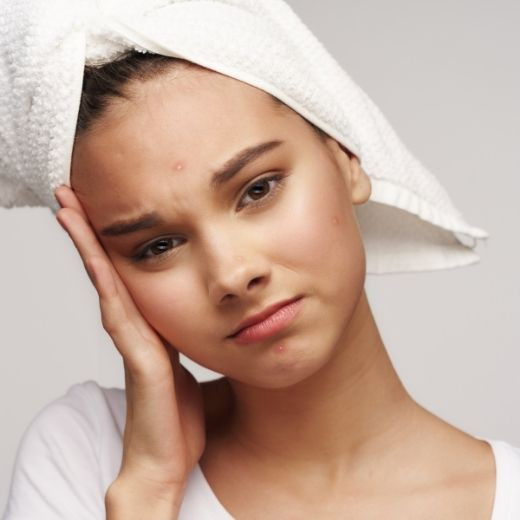Surprising Ways You Can Get Acne
Posted by Ellie Swain on Jan 27th 2022
Have you ever woken up to a host of unwanted blemishes on your face without really knowing the reason why?
Most of us will experience acne at some point in our lives, whether it’s an occasional spot or two or an unpleasant breakout.
But while most of us know that hormones play a huge part in whether we have acne or not, there are many other surprising ways you can develop acne.
We’re here to share some of them. Keep reading to get the scoop, along with some tips for keeping the dreaded acne at bay.
Hair Care products
Did you know that there’s a name for breakouts caused by hair care products? It’s pomade acne.
It makes sense that many styling products seep oil onto the forehead, which can trap bacteria into your pores. Clogged pores can inflate, leading to breakouts along the hairline and forehead.
Your hairstyle can affect your susceptibility to acne too. While bangs look cute, they can worsen acne by introducing skin-clogging hair products to your forehead.
In many cases, the products you apply to your hair end up on your face, especially if the formulas feature spray applicators.
Fortunately, it’s easy to tell if your hairstyle or the products you use on it are the culprits for your acne. If you’re developing an odd number of blemishes around the forehead and hairline, this may be a clear sign.
To avoid these types of blemishes, be sure to apply hair care products with your hands and keep them away from your hairline. After using your products, wipe your skin with a facial cleanser to wash away any stray product.
We love FOREO’sMicro-Foam Cleanser, which gently removes any dirt, products, or impurities collected on the skin. It also nourishes the complexion with naturally hydrating and skin-friendly ingredients, and it’s an excellent match for all skin types.
The skin is left silky-smooth even after the first use.
Traveling somewhere new
Ever wondered why your skin seems to erupt after returning from a vacation? It comes as no surprise that the change of environment, like the sun, heat, and humidity, can all trigger acne.
When you’re on vacation, depending on where you are, you often spend extended periods in the sun and spending time in the salty ocean and chlorine-filled pools. It’s often a far cry from what your skin is usually used to, and it reacts by breaking out.
While you can’t change the weather where you vacation, avoiding too much sun exposure and using a high-quality sunscreen with zinc oxide or titanium dioxide might help reduce unwanted acne while you’re on hols.
On vacation, remember that your skin adapts to environmental changes, so don’t give it extra stress by experimenting with new products.
Consider using the iS ClinicalEclipse SPF 50, which is designed for daily use and extended outdoor activity – perfect for the next vacation in a dreamy outdoor destination.
The product contains transparent titanium dioxide and micronized zinc oxide with pure vitamin E. Plus, it’s super sheer and lightweight, so you don’t need to worry about that common white film effect many sunscreens provide.
Using too many products
With so many new trending skin care products and ingredients constantly being introduced, it’s tempting to experiment.
While this is good for the cosmetics industry, it’s not so good for your skin.
Switching products or adding a new one to your routine before giving it the chance to work challenges your skin with new active ingredients and preservatives. This can irritate your complexion and sometimes cause breakouts.
And guess what? Even anti-acne products can contribute to blemishes if you use too many.
It’s tempting to switch to the next product if you don’t feel like the current one is working, but this can be rough on your skin.
Whatever skincare issues you’re trying to address, give any new products at least four to six weeks to work. While this sounds lengthy, it takes this long for the skin to turn over, so it needs that adjustment time.
Facial hair removal
When it comes to facial hair removal, you’re often switching one skincare issue for another.
Many products applied to the skin before or after hair removal are comedogenic, meaning that they clog pores and therefore encourage acne production.
Consider that itchy bumps resulting from hair removal may not be ‘true acne.’ Instead, it may be irritation of the hair follicle, creating a temporary rash.
If you end up with any of these bumps, relieve them by applying a warm compress to the face three or four times a day. If you don’t have much luck with this, see your doctor. You may need an antibiotic to clear the rash.
Do you want more acne care advice? Learn about Acne-Prone Routine Tips here .

